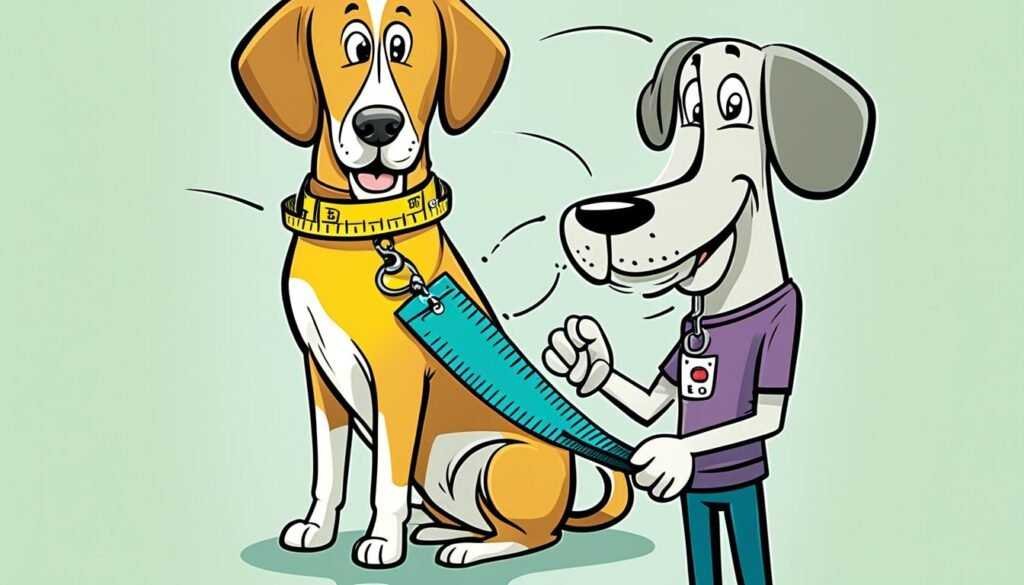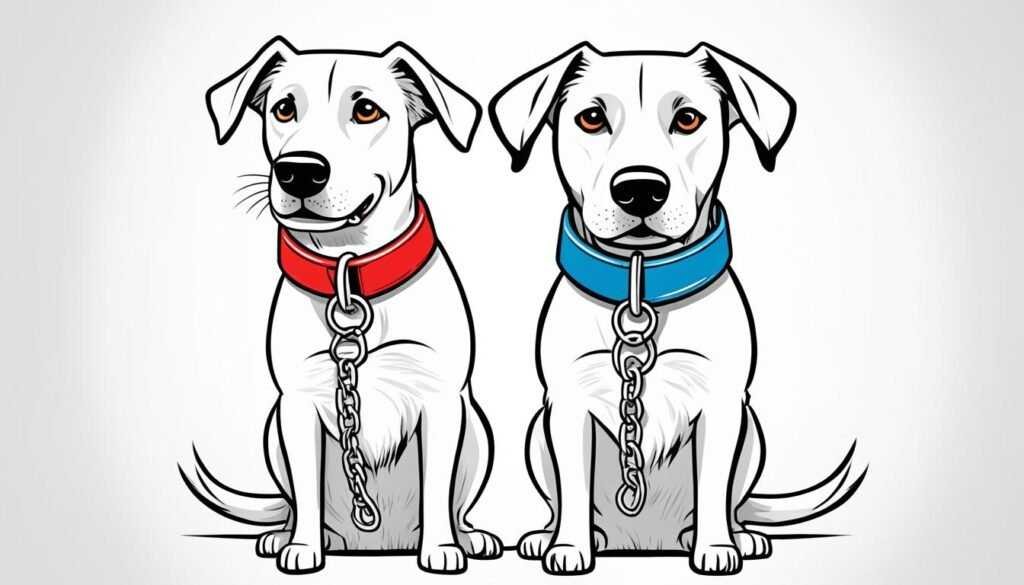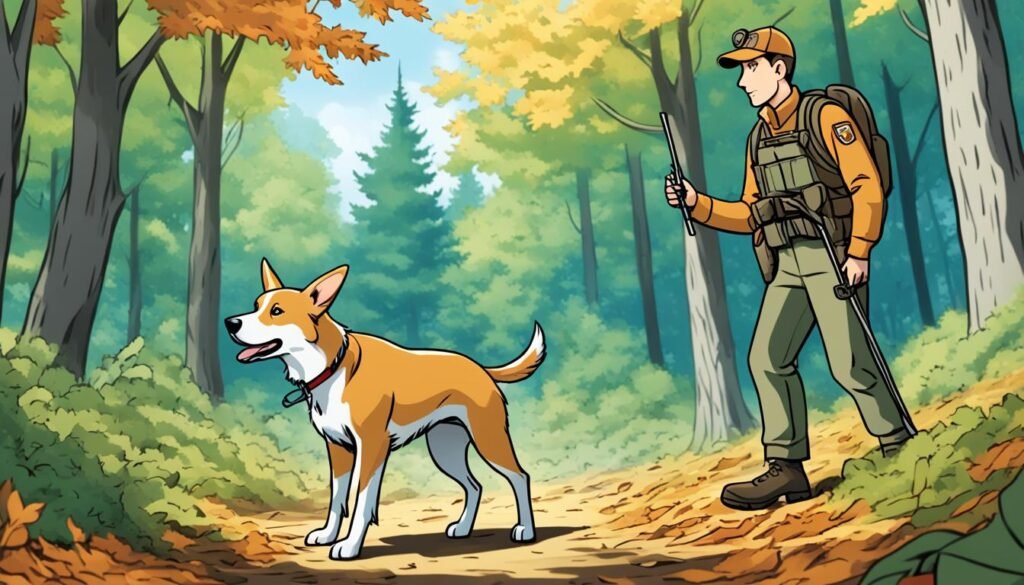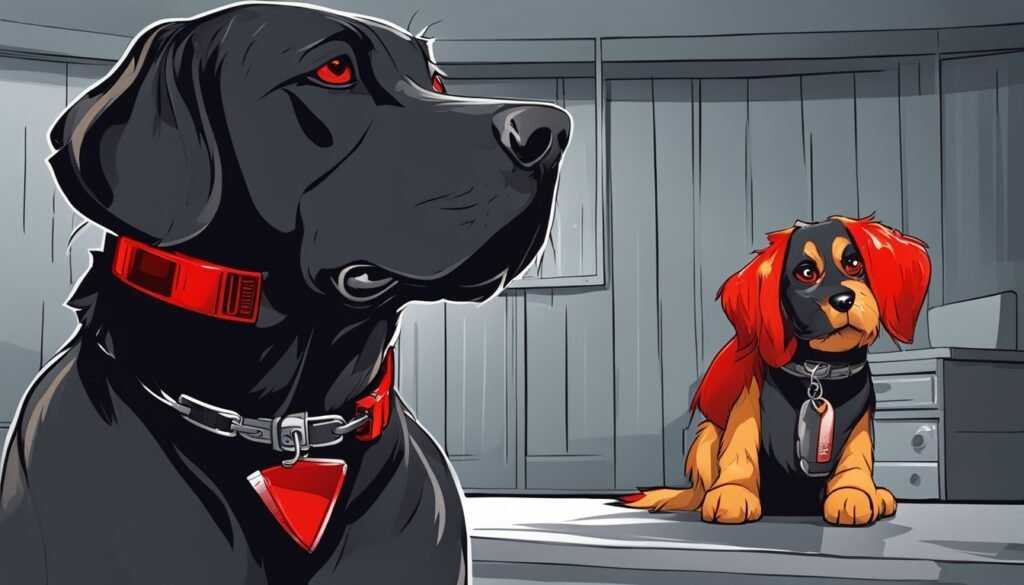As a responsible dog owner, knowing how to use choke collars safely is key. Choke collars can help with leash training and controlling dog behavior. But, using them wrong can hurt your dog.
This guide will teach you the basics of choke collars, how to pick the right one, and how to put it on correctly for walks and training.

Understanding Choke Collars
Choke collars, also known as choke chains or training collars, are made of metal links or chains. They help control a dog’s behavior, especially during walks. They stop pulling and other unwanted actions by tightening around the dog’s neck when pulled.
What is a Choke Collar?
A choke collar is a tool used in dog training. It has a chain or metal links that form a loop around the dog’s neck. When the leash is pulled, the collar tightens, creating a choking sensation to signal the dog to stop the behavior.
How Does a Choke Collar Work?
Choke collars apply pressure to the dog’s neck when the leash is pulled. This pressure is meant to stop the dog from pulling or doing unwanted behaviors. But, it’s crucial to use them carefully to avoid hurting the dog.
The collar has a special design with a sliding and a stationary ring. When the leash is pulled, the sliding ring tightens around the dog’s neck. This is meant to tell the dog that the behavior is not good and needs to stop.
While choke collars can help train some dogs, they should be used with care. If used wrongly, they can cause serious harm, like tracheal damage, nerve damage, or even a collapsed windpipe.
Choke collars and their risks,alternatives to choke collars, andunderstanding dog training collarsare key for pet owners to know.
“Choke and prong collars are designed to punish dogs for pulling by inflicting pain and discomfort.”
Preparing to Use a Choke Collar
Before you start using a choke collar on your dog, make sure you have the right size and know how to put it together. It’s key to pick the right choke collar size and assemble it correctly for training.
Choosing the Right Choke Collar
The choke collar should be about 2 inches longer than your dog’s neck. This extra length lets the collar fit over your dog’s head easily and sit right below the chin. This is where it needs to be for training to work well. Measuring your dog’s neck and picking the right collar size is the first step to using a choke collar safely.
Assembling the Choke Collar
- Take one end of the choke collar chain and thread it through the ring on the other end, forming a “P” shape.
- Adjust the size of the loop to be large enough to slip over your dog’s head comfortably.
- Make sure the chain is not twisted when assembling the collar, as this can affect its functionality.
- Once the collar is properly assembled, you can introduce it to your dog and begin the training process.
Choosing and assembling the choke collar correctly is key for your dog’s safety and the tool’s effectiveness. By following these steps, you can get ready to use the choke collar responsibly and with your dog’s safety in mind.

“Improper use of choke collars, such as tightening excessively or using them inappropriately in dog shows, can cause discomfort and harm to dogs.”
Remember, choke collars can be useful but should be used carefully and with professional guidance. Look into other training methods like positive reinforcement or no-pull harnesses to keep your dog safe and happy.
how to use a choke collar on a dog
Using a choke collar for dog training needs the right technique and knowledge. It’s best used during training, not all the time. This way, your dog stays safe and comfortable while learning obedience and leash manners.
- Have your dog sit and face you, then place the collar over their head, keeping the “P” shape. This is key for the collar to work right.
- Put the collar just behind the dog’s ears, not on their neck. This spot makes it easy to release and keeps your dog comfy.
- Attach the leash to the live ring on the collar. Keep the leash loose while walking. Pull gently on the leash only when you need to correct your dog.
- Release the pressure right away if your dog listens. The goal is to use the collar for training, not daily wear.
By following these steps, you can use the choke collar well for how to put on choke collar, using choke collar for dog training, and proper choke collar technique. Always use it with a pro’s help and don’t leave it on your dog too long.
“The choke collar should be put on when starting a training session and removed immediately after training, not left on for extended periods.”
Putting the choke collar on correctly is key for your dog’s comfort and safety. Wrong placement can cause discomfort and be dangerous. Always put the collar in a “P” shape over the head and behind the ears for safe training.

When using the choke collar, aim for gentle guidance and minimal correction. Avoid yanking or pulling the leash as it can hurt your dog and make bad behaviors worse. Instead, use gentle pressure by lifting the leash to signal what you want, and stop pulling once your dog does it.
Mastering how to put on choke collar, using choke collar for dog training, and proper choke collar technique helps fix behavior issues and makes training positive for your dog.
Fitting the Choke Collar
It’s key to fit the choke collar right for safe and effective use. The collar should be snug but still let you fit a few fingers between it and your dog’s neck. This makes sure the collar can move and correct your dog without hurting them.
Positioning the Choke Collar
Put the choke collar just behind your dog’s ears, not on the neck. This spot makes your dog react faster, helping with training. Make sure it doesn’t slide down to the neck, as it could block air and hurt your dog.
Attaching the Leash
Attach the leash to the live ring on the choke collar. This setup lets the chain move without tangling or forming a “U” shape. This way, the collar corrects your dog gently without hurting their neck.
A choke collar is for gentle correction, not punishment. Always get help from a pro dog trainer or expert to use it safely and right for your pet.

“Proper positioning and fitting of the choke collar are essential for its safe and effective use. Consult with a professional to ensure you’re using it correctly.”
Best Practices for Using Choke Collars
Choke collars are sometimes used in training dogs, but they must be used carefully. Following best practices helps minimize risks and promotes positive training. This ensures your dog’s safety and well-being.
Do’s and Don’ts
Here are important guidelines for using a choke collar:
- Do properly fit and position the collar to avoid discomfort or injury to your dog’s neck.
- Do use the choke collar only for training, releasing the pressure when your dog follows your commands.
- Do combine the choke collar with positive reinforcement, like treats or praise, for good behavior.
Here are practices to avoid with a choke collar:
- Don’t leave the choke collar on your dog when they are alone, as it’s a choking hazard.
- Don’t apply too much pressure or jerk the collar, as it causes pain and discomfort.
- Don’t use the choke collar as punishment, as it can make your dog fearful, anxious, and aggressive.
Choke collars should be used with caution and by those experienced in their use. For your dog’s safety, consider alternative methods like positive reinforcement and body harnesses. These are more humane and effective for addressing behavior issues.

Remember, training your dog is about building trust, not causing harm. By following these best practices, you can use choke collars safely and effectively. This way, you prioritize your dog’s well-being.
Conclusion
Choke collars can be helpful in training, but there are choke collar alternatives and humane dog training methods too. Options like positive reinforcement, harnesses, and getting advice from a pro dog trainer are good choices. They help improve your dog’s behavior safely and responsibly.
It’s important to weigh the risks and benefits of choke collars and look into other training ways. These methods focus on the dog’s safety and the bond with their owner.
By learning more, getting expert advice, and choosing humane dog training methods, you make training a positive experience for you and your dog.






